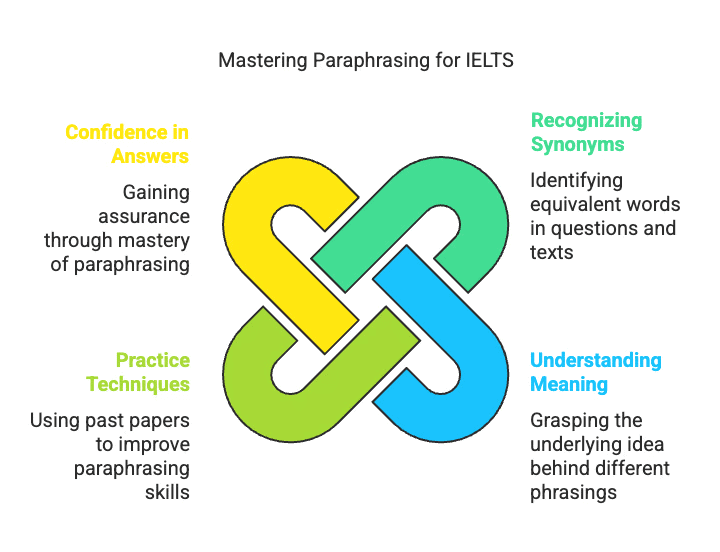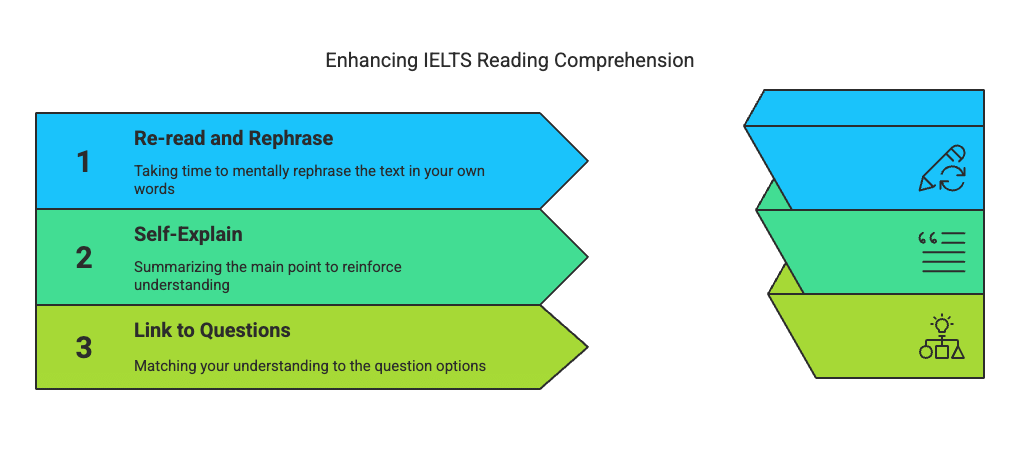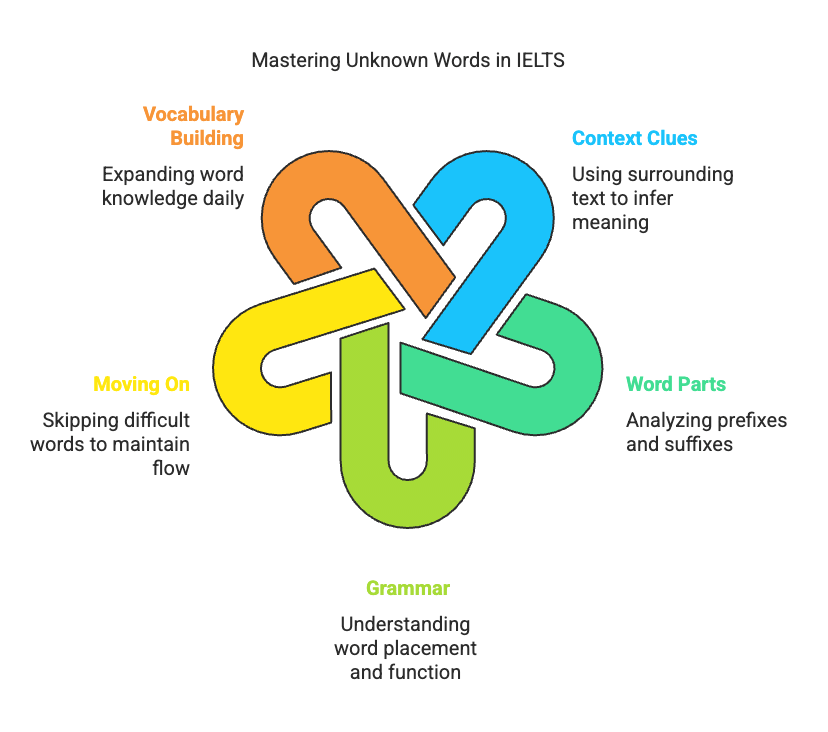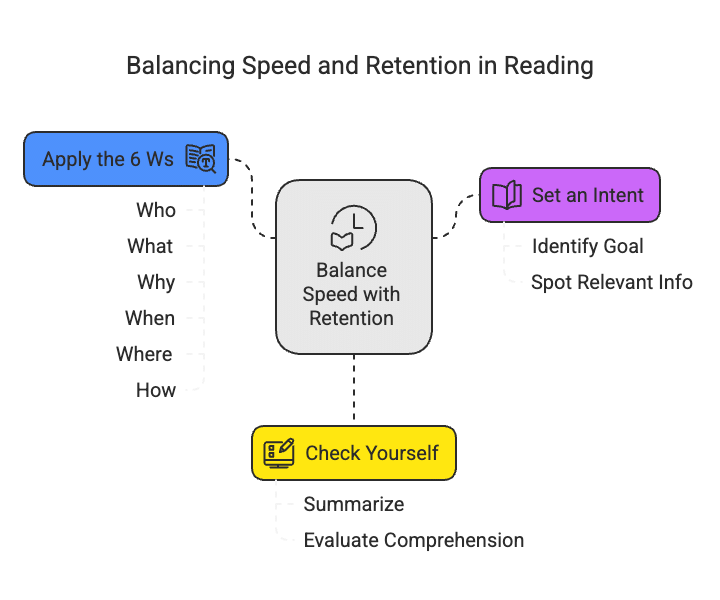17 Reading Tips to Improve your IELTS Score | Tips & Tricks to score 9 Bands in IELTS PDF Download
The IELTS Reading test challenges your ability to comprehend and analyse texts under time pressure. Success hinges on understanding how the test works and mastering efficient reading strategies. Here are three essential tips to improve your performance:
1. Master Paraphrasing – The Key to Finding Answers
Why It’s Crucial: Paraphrasing is the cornerstone of the IELTS Reading test. Every correct answer you select—whether from multiple-choice options, True/False/Not Given, or matching tasks—will have a corresponding section in the passage that expresses the same idea using different words. This tests your ability to recognize meaning beyond surface-level wording.
What It Means: The test doesn’t repeat question phrasing verbatim in the text. For example, a question might ask, “Does the writer support this idea?” while the passage says, “The author strongly endorses this view.” Both mean the same thing, but the language differs. Your task is to spot these equivalents.
How to Apply It:
- Look for Synonyms: If a question mentions “happiness,” scan for words like “joy,” “contentment,” or “well-being” in the text.
- Focus on Meaning: Don’t hunt for exact matches; understand the idea behind the question and find its rephrased version.
- Practice: Use past papers to match question phrases with paraphrased text segments. This sharpens your ability to decode language complexities, a skill IELTS rewards in higher bands (e.g., Band 7: "shows awareness of subtle differences in meaning").

Benefit: Once you grasp paraphrasing, you’ll confirm answers with confidence, as the text always holds the evidence—if you know where to look.
2. Skim Effectively – Get the Big Picture Fast
Why It’s Essential: The IELTS Reading test includes 3 passages (about 2,500-2,750 words total), and you have just 60 minutes. Reading slowly, as you might for leisure, wastes time and risks failure. Skimming lets you grasp the text’s structure and main ideas quickly, setting you up to answer questions efficiently.
What It Means: Skimming is a rapid reading technique to get an overview without focusing on details. It’s about identifying the gist—what the passage is about and how it’s organized.
How to Do It:
- Start Strong: Read the title and first paragraph carefully (1-2 minutes) to understand the topic and purpose (e.g., is it about climate change or technology?).
- Target Key Sentences: Focus on the first 1-2 sentences of each paragraph—these often contain the main idea. Glance at the rest for context.
- Finish Thoroughly: Read the last paragraph fully, as it often summarizes the text or presents conclusions.
- Time Limit: Aim to skim each passage in 2-3 minutes before tackling questions.
Benefit: Skimming saves time and helps you locate relevant sections later when answering questions. It’s about speed with purpose, not careless rushing.
3. Scan Strategically – Zero In on Specific Details
Why It’s Critical: Many IELTS Reading questions (e.g., gap fills, matching headings) require you to find precise information like dates, names, numbers, or terms. Scanning lets you pinpoint these details quickly under time pressure, avoiding the trap of rereading entire paragraphs.
What It Means: Scanning is a focused, fast sweep of the text to locate specific facts or keywords, ignoring unrelated content. It’s like using a search function in your mind.
How to Do It:
- Identify Keywords: From each question, pick out standout words (e.g., “2020,” “Smith,” “population”) or ideas (e.g., “cost” might be “price” or “expense” in the text).
- Sweep the Text: Move your eyes quickly over the passage, looking for these keywords or their synonyms. Don’t read full sentences yet—just spot the target.
- Highlight Smartly: Underline or circle key details (e.g., years, percentages, names) as you scan. This marks your map for answering later.
- Stay Alert: Limit scanning to 1-2 minutes per question set. Speed and focus are vital—relaxed reading won’t cut it.
Benefit: Scanning pairs with skimming: after getting the overview, you zoom in on answers efficiently. For example, if a question asks about “sales in 2018,” scan for “2018” and nearby numbers, then verify with context.
4. Prioritise Ideas Over Words – Unlock the Meaning
Why It’s Crucial: The IELTS Reading test isn’t about memorizing exact wording—it’s about grasping concepts. Answers are always paraphrased, so fixating on specific words can mislead you. Focusing on ideas ensures you understand the message, aligning with the test’s emphasis on comprehension.
What It Means: Instead of getting stuck on the text’s surface language, distill the passage into its core meaning. For instance, if a paragraph discusses “rising pollution levels,” the question might rephrase it as “increasing environmental damage.” Recognizing the idea links the two.
How to Apply It:
- Re-read and Rephrase: After skimming a paragraph, pause briefly (10-15 seconds) and mentally rephrase it in your own words (e.g., “Pollution’s getting worse” instead of the original phrasing).
- Self-Explain: Silently summarize the main point to yourself (e.g., “This is about why pollution’s a problem”). This mini-analysis shifts your focus from vocabulary to intent.
- Link to Questions: When you tackle questions, match your rephrased understanding to the options, not the exact text. The answer’s meaning will mirror the passage’s idea, not its wording.
Benefit: This habit trains you to see through paraphrasing, a skill IELTS rewards in higher bands (e.g., Band 7: "interprets implied meaning effectively"). You’ll spot answers faster by thinking conceptually.

5. Experiment with Strategies – Find Your Best Fit
Why It’s Essential: There’s no one-size-fits-all method for the IELTS Reading test. Different approaches suit different learners, and what works for others might not work for you. Testing strategies help you discover the most effective way to manage time and accuracy.
What It Means: Strategies vary—some prefer reading questions first to hunt for answers, while others skim the passage first for context. The “winner” is the method that consistently yields your highest practice scores.
How to Do It:
- Try Questions First: Read the questions before the passage, noting keywords (e.g., “2019,” “cost”). Then skim/scan the text to find matches. This focuses your reading but may overwhelm if questions are complex.
- Try Passage First: Skim the passage (2-3 minutes) to grasp its structure and ideas, then tackle questions. This builds context but requires quick retention.
- Test and Measure: Use practice tests (e.g., Cambridge IELTS books) to try both methods. Time yourself (60 minutes total) and score each attempt. Compare results—the highest score wins.
- Refine: Once you pick a strategy, practice it repeatedly to perfect pacing and confidence.
Benefit: Personalizing your approach optimizes efficiency and reduces stress. Band 7+ candidates “adapt strategies to task demands,” and this tip helps you find that edge.
6. Adopt a Passage-First Strategy – Simplify Your Process
Why It’s Effective: Juggling questions and text simultaneously can overload your brain, slowing you down. Reading the passage first consolidates information, making it easier to locate answers when you see the questions.
What It Means: This strategy prioritizes understanding the text as a single unit before splitting attention to questions. It leverages short-term memory to connect ideas to answers seamlessly.
How to Apply It:
- Skim Rapidly: Spend 2-3 minutes skimming the passage—focus on the title, first paragraph, topic sentences, and conclusion to get the gist (e.g., “This is about tech growth”).
- Mental Recap: After skimming, take 10-15 seconds to summarize the main idea in your head (e.g., “Tech’s expanding fast, especially in cities”). Don’t overthink—just capture the essence.
- Move to Questions: Read the questions and options, then scan back to the text for answers. Your prior understanding guides you to the right section (e.g., “Tech growth? That’s paragraph 3”).
- Stay Focused: Avoid distractions—keep your brain locked on the passage’s ideas, not the question details, until you’re ready to answer.
Benefit: This method reduces cognitive strain, letting you process one task at a time. It’s ideal for Band 7+ aspirants who “manage time and focus effectively,” as it streamlines comprehension and retrieval.
7. Locate and Mark Evidence – Confirm Your Answers with Precision
Why It’s Crucial: The IELTS Reading test embeds every correct answer in the passage, rephrased but unmistakable. Pinpointing this evidence ensures you’re not guessing, locking in accuracy—a hallmark of Band 7+ performance ("selects key information with confidence").
What It Means: Each question has one definitive answer, supported by a specific line or phrase in the text. Finding and marking this proof eliminates doubt, proving you’ve matched the question to its paraphrased counterpart.
How to Apply It:
- Track the Answer: After skimming, scan for the rephrased idea matching the question (e.g., question says “improved health,” text says “better well-being”). Compare keywords or synonyms to confirm.
- Underline It: Draw a line under the exact sentence or phrase in the passage that holds the answer (e.g., “Studies show enhanced well-being in urban areas”).
- Number It: Write the question number (e.g., “Q5”) above the underlined text. This links the proof to the question on your answer sheet.
- Stay Disciplined: Do this for every answer to avoid lazy guesses. It takes seconds but builds certainty—there’s always one correct option, as IELTS tests are designed with precision.
Benefit: This method roots your answers in the text, reducing errors and boosting confidence. It’s a systematic way to verify choices, especially under time pressure.
8. Handle Unknown Words Calmly – Decode with Context
Why It’s Essential: You’ll encounter unfamiliar vocabulary in the IELTS Reading test—academic passages often use technical or advanced terms. Panicking wastes time, but context can reveal meaning, keeping you on track for Band 7+ ("uses context to infer meaning effectively").
What It Means: Instead of fixating on a mystery word, use surrounding clues to guess its role or sense. You don’t need to know every term to answer correctly—focus on the bigger picture.
How to Do It:
- Check the Sentence: Look at words around the unknown term. For example, in “The arboreal habitat thrived,” “thrived” suggests something positive, hinting “arboreal” relates to a living environment (it means tree-related).
- Use Word Parts: Spot prefixes or suffixes—e.g., “un-” (not, e.g., “unseen” = not seen), “re-” (again, e.g., “rebuild” = build again), or “-wise” (regarding, e.g., “clockwise” = direction-related). Prefixes are added to the front of a word to tweak its meaning. For example:“Un-” means “not.” If you see “unseen,” break it down: “seen” (something you’ve looked at) + “un-” (not) = “not seen.” So, “unseen” means hidden or unnoticed. “Re-” means “again.” Take “rebuild”: “build” (make something) + “re-” (again) = “build again.” It’s fixing or making something a second time.
Suffixes go at the end and often show what kind of word it is or add a twist. For example: “-Wise” means “about” or “related to.” In “clockwise,” “clock” (time tool) + “-wise” (related to) = “moving like a clock’s hands.” It’s about direction. - Leverage Grammar: Position matters—if it’s before a noun (e.g., “vast plains”), it’s likely an adjective (describing size). After a verb (e.g., “she ran swiftly”), it’s probably an adverb.
- Move On if Stuck: If context fails, don’t dwell—skip to the next question and revisit later with a fresh perspective.
Prep Tip: Build vocabulary daily (e.g., learn 5-10 new words, like “mitigate” or “prolific”) and study common prefixes/suffixes to guess meanings on the fly.
Benefit: This keeps you calm and efficient, turning obstacles into opportunities. You’ll answer more questions without getting derailed by a single word.

9. Fill Every Blank – Guess Smart When Time Runs Out
Why It’s Smart: The IELTS Reading test doesn’t penalise wrong answers—only unanswered ones guarantee zero points. Guessing in the final moments can turn luck into extra marks, potentially lifting you from Band 6.5 to 7.0.
What It Means: Leaving a question blank is a missed chance. With no negative marking, a random guess has a shot at being right, especially in multiple-choice or True/False/Not Given tasks.
How to Do It:
- Monitor Time: Aim to finish with 2-3 minutes left to review. If you’re behind, speed up in the last passage.
- Guess Strategically: When time’s up (e.g., last 30 seconds), pick an option for every blank. For True/False/Not Given, “Not Given” is often a safe bet if unsure (statistically common). For multiple-choice, choose “C” or a middle option if clueless—it’s a neutral guess.
- Fill Everything: Scribble answers on the sheet—blanks score nothing, but a guess might score 1 point each.
- Stay Positive: Even one lucky hit can boost your raw score (e.g., 27/40 ≈ Band 6.5, 30/40 ≈ Band 7).
Benefit: This maximizes your score potential. A single point can make a difference, and guessing ensures you’re in the game until the end.
10. Boost Your Reading Speed – Master Time Management
Why It’s Vital: With only 60 minutes, slow reading leaves you scrambling—the average pace must hit 40-50 words per minute to skim effectively. Enhancing your speed during preparation ensures you cover all passages and questions, a key trait for Band 7+ ("manages time efficiently").
What It Means: Reading speed isn’t just about racing through text—it’s about processing more words quickly while retaining meaning. This balances the test’s time pressure with its comprehension demands.
How to Improve It:
- Widen Your Gaze: Train your eyes to capture 3-5 words per glance instead of reading word by word. For example, read “The cat sat quietly” as one chunk, not four separate stops. Gradually expand to 5-word chunks (e.g., “The cat sat quietly waiting”).
- Use a Pointer: Guide your eyes with a pen or finger, landing between every 3-5 words. Move it steadily faster across lines to push your pace—aim for smooth, rhythmic progress.
- Balance Speed and Understanding: Speed is useless without recall. Test yourself after each passage (e.g., “What’s the main idea?”) or use online comprehension quizzes (e.g., BBC Learning English) to ensure you’re not skimming blindly.
- Practice Daily: Spend 10-15 minutes on news articles or short essays, timing yourself to beat your previous record while summarizing key points.
Benefit: Faster reading frees time for tricky questions, reducing stress and boosting accuracy—crucial for hitting 30+ correct answers (Band 7+ territory).
11. Leverage Smart Reading Tools – Enhance Efficiency and Vocabulary
Why It’s Effective: Tools can accelerate your preparation by training speed and expanding vocabulary, two pillars of IELTS success. They turn practice into a dynamic, interactive process, supporting Band 7+ skills ("uses resources to improve language awareness").
What It Means: Technology aids like speed-reading apps and e-readers streamline how you process text and learn new words, making preparation more engaging and effective.
Top Tools and How to Use Them:
- ZapReader (Free Web Version): This tool flashes text in chunks (e.g., 3-5 words) at adjustable speeds. Load a practice passage, set it to 200-300 words per minute, and read as it “chunks” the text. Start slow, then ramp up to widen your gaze. No purchase needed—just use the online version.
- Amazon Kindle: Perfect for vocabulary growth. Highlight unknown words (e.g., “profound”) to see instant definitions, then save them as flashcards. Review these daily (5-10 minutes) to master terms like “mitigate” or “ubiquitous.” I’ve used this to boost my English and Spanish skills—it’s a game-changer.
- Audible: Pair audiobooks with Kindle texts (e.g., listen to The Great Gatsby while reading it). This reinforces comprehension and pronunciation, catching details you might miss in text alone. It’s like a double dose of learning—ideal for deeper retention.
Benefit: These tools build speed and word power efficiently, preparing you for the test’s pace and academic vocabulary demands.
12. Select Practice Materials Wisely – Stay Motivated and Level-Appropriate
Why It’s Key: The right material keeps you engaged and builds skills progressively, avoiding burnout or frustration. Long-term language improvement complements short-term exam practice, pushing you toward Band 7+ ("shows sustained effort in language development").
What It Means: Boredom kills progress—choosing topics you enjoy sustains your reading habit, while matching difficulty to your level prevents overwhelm. It’s about building fluency, not just exam tricks.
How to Choose and Use It:
- Pick Your Passion: Opt for subjects you love—e.g., tech articles if you’re a gadget fan, or sports reports if you’re an athlete. Interest drives persistence, so you’ll read more (e.g., 20 pages vs. 2).
- Match Your Level: Start with accessible texts—e.g., young adult novels like Harry Potter (readable English, Spanish, etc.) over dense classics like War and Peace. I tried Tolstoy in Spanish and quit; Harry Potter kept me hooked. Gradually scale up as confidence grows.
- Mix with IELTS Practice: Use past papers (e.g., Cambridge IELTS) for exam format, but supplement with 1-2 hours weekly of fun reading (e.g., National Geographic). This builds vocab and stamina subtly.
- Track Progress: Note new words or faster reading times weekly—small wins keep you motivated.
Benefit: Enjoyable, level-appropriate reading strengthens language skills holistically, making IELTS passages feel less daunting over time.
13. Balance Speed with Retention – Don’t Lose the Meaning
Why It’s Crucial: Speed-reading is vital, but racing through text without grasping ideas defeats the purpose—IELTS tests comprehension, not just pace. Retaining key points ensures you answer accurately, a Band 7+ trait ("maintains understanding despite complexity").
What It Means: As you push your reading speed, retention can slip—your brain skims but forgets. Anchoring yourself with active questions keeps the message clear, preventing you from missing paraphrased answers.
How to Do It:
- Apply the 6 Ws: After skimming a paragraph, pause (10-15 seconds) and ask: Who’s involved? What’s happening? Why’s it occurring? When? Where? How’s it done? For example, in a text about climate change: Who: scientists, What: research, Why: rising temperatures, When: 2020s, Where: globally, How: data analysis.
- Set an Intent: Before reading, ask, “What’s my goal here?” (e.g., “Understand tech trends”). This primes you to spot relevant info (e.g., “AI growth” stands out). Test it after: “What did I learn?”
- Check Yourself: Post-paragraph, mentally summarize (e.g., “Tech’s advancing fast”). If you draw a blank, slow down—comprehension trumps speed every time.
Benefit: This keeps your brain engaged, linking speed to meaning. You’ll recall details to nail questions, not just fly through text blindly.

14. Structure Your Reading Time – Sharpen Your Focus
Why It’s Essential: Distractions derail reading—wandering thoughts or phone checks waste precious minutes. A structured approach boosts concentration, critical for Band 7+ ("sustains focus across extended tasks").
What It Means: Focus falters without a plan, especially with dry IELTS passages. Setting a time, place, and barriers against distractions turns reading into a deliberate, productive act.
How to Apply It:
- Time Blocks: Set a timer for 30 minutes—long enough to dive in, short enough to stay sharp. Start with one block daily, then build to two as stamina grows.
- Create a Zone: Pick a quiet spot (e.g., desk at home, not a noisy café). Switch your phone to airplane mode, wear headphones (try rain sounds or white noise—I swear by it), and clear clutter.
- Eliminate Interruptions: Tell yourself, “No Reddit, no snacks—just 30 minutes of focus.” Headphones block ambient noise (e.g., chatter, traffic), keeping your mind on the page.
- Reflect: After each session, note if you drifted—adjust next time (e.g., shorter blocks if 30 feels long).
Benefit: A distraction-free setup mimics test conditions, training you to zero in on passages without losing momentum—key for finishing on time.
15. Enhance Reading Comprehension – Practice Makes Perfect
Why It’s Key: Tips build skills, but practice cements them—IELTS rewards those who apply strategies consistently. Strong comprehension unlocks paraphrased answers, pushing you to Band 7+ ("interprets complex texts accurately").
What It Means: Comprehension grows with exposure—regular practice with varied texts hones your ability to grasp ideas fast, even under pressure.
How to Do It:
- Use Official Resources: Start with free online tests. British Council (britishcouncil.org) and IELTS Practice Tests (ielts.org) offer authentic passages. Aim for 1-2 weekly, timing yourself (60 minutes).
- Tap ESL Options: Exhausted freebies? Grab Cambridge IELTS books (e.g., 17 or 18)—they craft the real test, so quality’s top-notch. Try C1/C2-level ESL texts for a challenge (e.g., Cambridge English Advanced).
- Make It Fun: Open a book (e.g., The Hobbit), read a random page, then write a 2-3 sentence summary (e.g., “Bilbo finds a ring; it’s mysterious”). This tests recall without exam pressure—I love this trick.
- Review Mistakes: After each test, analyze errors—missed a paraphrase? Misread a keyword? Fix it next time.
Benefit: Practice bridges theory to results, sharpening your eye for details and patterns—exactly what IELTS demands.
16. Engage Actively with the Text – Mark It Up Strategically
Why It’s Crucial: Active reading keeps you involved, especially in the paper-based IELTS test, where you can annotate directly. Marking the passage highlights key details, speeding up answer retrieval—a Band 7+ skill ("locates information efficiently").
What It Means: Rather than passively scanning, you interact with the text—flagging phrases, keywords, and ideas that unlock meaning or answers. It’s like leaving breadcrumbs to guide you back.
How to Do It:
- Underline Key Phrases: Spot sentences that summarize or clarify the passage (e.g., “Climate change accelerated in 2020”). Underline these—they often hold paraphrased answers.
- Circle Keywords: Mark standout terms tied to questions (e.g., “2020,” “pollution,” “research”)—these are your anchors for scanning later.
- Add Margin Notes: Jot asterisks (*) or small symbols (e.g., “!”) beside critical sections (e.g., conclusions, stats). Write question numbers (e.g., “Q3”) if they match instantly.
- Keep It Quick: Limit marks to 1-2 per paragraph—overdoing it slows you down. Practice on sample tests to find your rhythm (e.g., 2-3 minutes skimming + marking).
Benefit: Annotations turn the passage into a map—when questions hit, you zip to circled dates or underlined ideas, cutting search time. It’s a proactive edge for the paper test.
17. Tap Into Quality Practice Resources – Supercharge Your Prep with Top Tools
Why It’s Essential: Practicing with high-quality, IELTS-aligned resources builds familiarity with passage styles and question types, boosting your confidence and skills. This mirrors Band 7+ preparedness ("applies practice effectively to test conditions").
What It Means: Beyond basic strategies, curated videos, documents, and tests expose you to real IELTS challenges—academic texts, tricky paraphrasing, and diverse formats (e.g., Matching Headings, True/False/Not Given)—sharpening your edge.
Recommended Resources and How to Use Them:
1. Core Tutorials:
- 15 Reading Tips for IELTS – A broad starter guide. Watch once (20-30 minutes) to grasp key strategies like skimming and scanning, then revisit weekly.
- Techniques to Read Faster – Boosts speed. Practice its tips (e.g., chunking words) on a 500-word article daily for 10 minutes.
- How to Get 8+ Bands in Reading – Band 7+ roadmap. Take notes and apply one tip per practice test (e.g., “focus on keywords”).
- How to Answer Diagram Label Completion Type of Questions – Visual task prep. Study (15 minutes), then test with a sample diagram question.
2. Practice Tests:
- Yes/No/Not Given: Practice Tests: Tricky type practice. Time it (20 minutes), aim for 80% accuracy, and review misses.
- Matching Sentence Endings Tests: Sentence logic drill. Do one (25 minutes), checking how endings align with text ideas.
- Short Answer: Practice Test: Quick recall test. Complete in 15 minutes, verifying answers against the passage.
- Diagram Label Completion: Diagram skill hone. Pair with the guide above, timing to 20 minutes.
3. Question-Type Mastery:
- Tips to Answer Matching Information Type of Questions: Clarifies a common task. Pair with Matching Sentence Endings: Practice Tests for 30-minute practice.
- How to Answer Diagram Label Completion Type of Questions – Simplifies visuals. Use with Practice Tests and time it to 20 minutes.
- How to Answer Multiple Choice Type of Questions – Sharpens choice skills. Follow with a Cambridge IELTS test section (e.g., Book 17, Test 1).
How to Use: Start with tutorials (1-2 weekly, 20-30 minutes each), then rotate practice tests (1-2 weekly, 60 minutes each). Focus on weak areas.
Benefit: These resources—sourced from IELTS experts—replicate test conditions, refine techniques, and target specific skills. You’ll face the exam ready for any curveball.
|
27 videos|1 docs
|
FAQs on 17 Reading Tips to Improve your IELTS Score - Tips & Tricks to score 9 Bands in IELTS
| 1. How can I improve my IELTS reading score? |  |
| 2. What are some effective strategies for skimming and scanning in the IELTS reading test? |  |
| 3. How can I improve my reading speed for the IELTS test? |  |
| 4. What are the common question types in the IELTS reading test? |  |
| 5. How can I effectively manage my time during the IELTS reading test? |  |





















